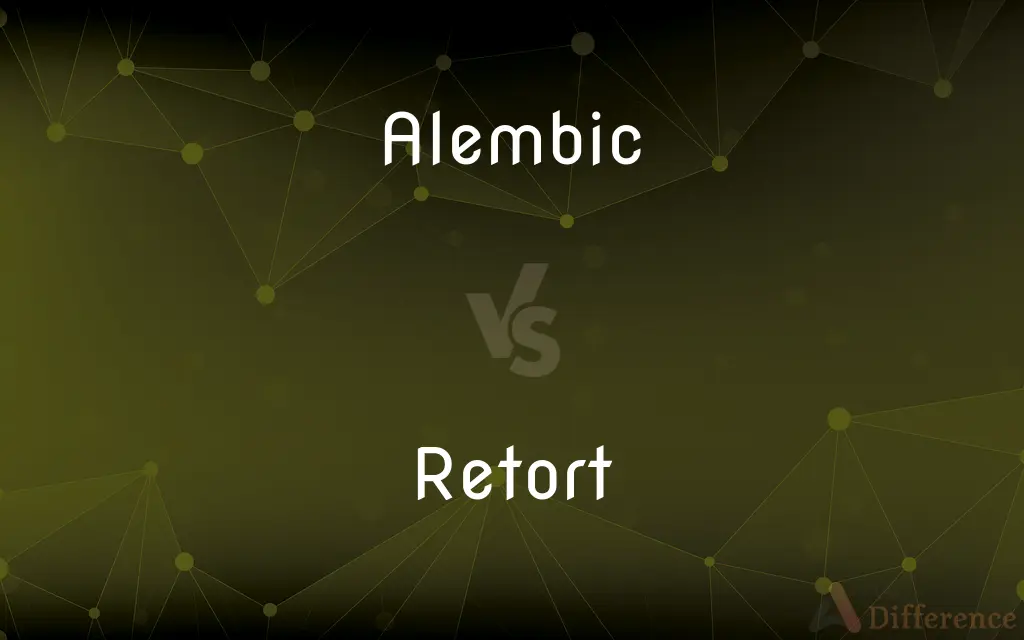Alembic vs. Retort — What's the Difference?
By Tayyaba Rehman & Urooj Arif — Updated on March 28, 2024
An alembic is a distillation apparatus traditionally used in chemistry and alchemy for purifying substances, while a retort is a glassware used for distillation or chemical reactions involving substances being heated and vaporized.

Difference Between Alembic and Retort
Table of Contents
ADVERTISEMENT
Key Differences
An alembic is characterized by its distinctive components: a boiler and a cooling unit, used for the process of distillation to separate or purify liquids. It has historical significance in the field of alchemy and early chemistry. Whereas, a retort is a laboratory glassware with a long, downward-curving neck, designed for heating chemical compounds, facilitating reactions or distillations.
Alembics are primarily associated with the distillation of alcoholic spirits and essential oils, utilizing their ability to condense vapor back into liquid form. On the other hand, retorts are versatile and used for a variety of chemical reactions that require substances to be heated under reflux or distilled.
The design of an alembic, with its spherical bottom and a tube leading to a condenser, is optimized for the efficient collection of distilled substances. While a retort, with its distinctive bent neck, allows for direct heating of substances and collection of distilled or reacted products in a separate container.
Alembics often symbolize the traditional and historical aspects of distillation and chemistry, reflecting ancient practices. In contrast, retorts, although also historical, have evolved into more modern forms of laboratory equipment used for specific types of chemical processing.
Despite their differences, both alembics and retorts serve crucial roles in the separation, purification, and chemical reaction processes. Their use is determined by the specific requirements of the process, whether it's for distillation, extraction, or chemical reactions.
ADVERTISEMENT
Comparison Chart
Definition
A distillation apparatus with a boiler and a cooling unit.
A laboratory glassware with a long, downward-curving neck for heating substances.
Primary Use
Distillation of liquids, especially for purifying spirits and essential oils.
Heating chemical compounds for reactions or distillation.
Design Features
Spherical bottom with a tube leading to a condenser.
Long neck bent downwards for directing vapor or liquid.
Symbolism
Traditional and historical in alchemy and early chemistry.
Represents historical chemical processes with some modern adaptations.
Versatility
Optimized for the distillation process.
Used for a variety of chemical reactions beyond distillation.
Compare with Definitions
Alembic
A tool for distilling substances.
The perfumer used an alembic to extract essential oils from flowers.
Retort
A tool for conducting chemical reactions under heat.
The retort was essential for the scientist’s experiments on reaction kinetics.
Alembic
Distillation equipment with historical significance.
The museum displayed an alembic used in medieval chemistry.
Retort
Glassware for heating chemicals in a lab.
The chemist placed the compound into the retort for distillation.
Alembic
An apparatus in alchemy for purifying liquids.
The ancient alchemist carefully set up the alembic for his experiments.
Retort
A laboratory apparatus with a distinctive shape.
The retort’s curved neck directed the distilled substance into a collection flask.
Alembic
A device for condensing vapor into liquid.
The alembic collected the purified alcohol after distillation.
Retort
A piece of classic chemistry equipment.
The retort, once a staple in laboratories, symbolizes the evolution of chemical engineering.
Alembic
A symbol of transformation in alchemy.
The alembic represents the alchemist’s goal of turning base metals into gold.
Retort
Equipment for vaporizing and collecting liquids.
Using the retort, the technician separated the solvent from the solution.
Alembic
An alembic (from Arabic: الإنبيق, romanized: al-inbīq, originating from Ancient Greek: ἄμβιξ, romanized: ambix, 'cup, beaker') is an alchemical still consisting of two vessels connected by a tube, used for distillation of liquids.
Retort
In a chemistry laboratory, a retort is a device used for distillation or dry distillation of substances. It consists of a spherical vessel with a long downward-pointing neck.
Alembic
An apparatus consisting of two vessels connected by a tube, formerly used for distilling liquids.
Retort
Say something in answer to a remark, typically in a sharp, angry, or witty manner
He retorted that this was nonsense
‘No need to be rude,’ retorted Isabel
Alembic
A device that purifies or alters by a process comparable to distillation.
Retort
Repay (an insult or injury)
It was now his time to retort the humiliation
Alembic
An early chemical apparatus, consisting of two retorts connected by a tube, used to purify substances by distillation.
Retort
Heat in a retort in order to separate or purify
The raw shale is retorted at four crude oil works
Alembic
An apparatus formerly used in distillation, usually made of glass or metal. It has mostly given place to the retort and worm still.
Retort
A sharp, angry, or witty reply
She opened her mouth to make a suitably cutting retort
Alembic
An obsolete kind of container used for distillation; two retorts connected by a tube
Retort
A container or furnace for carrying out a chemical process on a large or industrial scale
Gas was made by baking coal in airtight retorts
Retort
To reply, especially to answer in a quick, caustic, or witty manner.
Retort
To present a counterargument to (an argument or accusation).
Retort
(Archaic) To return in kind; pay back.
Retort
To make a reply, especially a quick, caustic, or witty one.
Retort
To present a counterargument.
Retort
(Archaic) To return like for like; retaliate.
Retort
A quick incisive reply, especially one that turns the first speaker's words to that speaker's own disadvantage.
Retort
The act or an instance of retorting.
Retort
A closed laboratory vessel with an outlet tube, used for distillation, sublimation, or decomposition by heat.
Retort
A sharp or witty reply, or one which turns an argument against its originator; a comeback.
Retort
(chemistry) A flask with a rounded base and a long neck that is bent down and tapered, used to heat a liquid for distillation.
Retort
An airtight vessel in which material is subjected to high temperatures in the chemical industry or as part of an industrial manufacturing process, especially during the smelting and forging of metal.
Retort
A pressure cooker.
Retort
A crematory furnace.
Retort
To say something sharp or witty in answer to a remark or accusation.
Retort
To make a remark which reverses an argument upon its originator; to return, as an argument, accusation, censure, or incivility.
To retort the charge of vanity
Retort
To bend or curve back.
A retorted line
Retort
To throw back; to reverberate; to reflect.
Retort
(transitive) To heat in a retort.
Retort
To bend or curve back; as, a retorted line.
With retorted head, pruned themselves as they floated.
Retort
To throw back; to reverberate; to reflect.
As when his virtues, shining upon others,Heat them and they retort that heat againTo the first giver.
Retort
To return, as an argument, accusation, censure, or incivility; as, to retort the charge of vanity.
And with retorted scorn his back he turned.
Retort
To return an argument or a charge; to make a severe reply.
Retort
The return of, or reply to, an argument, charge, censure, incivility, taunt, or witticism; a quick and witty or severe response.
This is called the retort courteous.
Retort
A vessel in which substances are subjected to distillation or decomposition by heat. It is made of different forms and materials for different uses, as a bulb of glass with a curved beak to enter a receiver for general chemical operations, or a cylinder or semicylinder of cast iron for the manufacture of gas in gas works.
Retort
A quick reply to a question or remark (especially a witty or critical one);
It brought a sharp rejoinder from the teacher
Retort
A vessel where substances are distilled or decomposed by heat
Retort
Answer back
Common Curiosities
What is an alembic used for?
An alembic is used for distilling substances, particularly in purifying spirits and essential oils.
Is a retort still used in modern laboratories?
While the traditional retort has largely been replaced by more modern equipment, its design principles are reflected in current laboratory apparatuses for specific processes.
What distinguishes an alembic from a retort?
An alembic is specifically designed for distillation with a boiler and condenser, while a retort is used for heating substances and can facilitate various chemical reactions.
What is the historical significance of an alembic?
The alembic has historical significance in alchemy and the early development of chemistry, symbolizing the quest for knowledge and the purification of substances.
Why would a chemist choose a retort over an alembic?
A chemist might choose a retort over an alembic for tasks requiring direct heating of substances and a more versatile application beyond simple distillation.
Can alembics and retorts be used interchangeably?
While they have overlapping functions, their design differences make them more suited to specific tasks; thus, they are not entirely interchangeable.
Can an alembic be used for chemical reactions other than distillation?
While primarily for distillation, alembics can be adapted for certain types of reactions related to purifying liquids.
How does a retort work?
A retort works by heating substances, allowing for chemical reactions or the distillation of compounds.
What materials are alembics and retorts made from?
Traditionally, alembics were made from copper or glass, while retorts were primarily glass to withstand heat and allow for observation of reactions.
How are alembics and retorts similar?
Both are used in the process of heating substances for distillation or chemical reactions, serving to separate or purify compounds.
How do the design features of an alembic contribute to its function?
The alembic’s design, including the boiler for heating and condenser for cooling, optimizes the process of distilling and purifying substances by condensing vapor back into liquid.
What advancements have replaced the retort in modern labs?
Modern labs use more advanced distillation columns, reaction vessels, and specialized glassware designed for efficiency and safety.
What role did the retort play in the development of chemistry?
The retort was crucial in the development of chemistry, allowing early chemists to conduct distillations and chemical reactions, leading to discoveries about the nature of substances.
How has the use of alembics evolved over time?
Alembics have evolved from alchemical tools to essential equipment in the production of perfumes, spirits, and pharmaceuticals.
What are the limitations of using a retort?
The limitations include its less efficient cooling system compared to modern distillation setups and the potential for breakage due to its glass construction.
Share Your Discovery

Previous Comparison
Pooling vs. Polling
Next Comparison
Alcove vs. CoveAuthor Spotlight
Written by
Tayyaba RehmanTayyaba Rehman is a distinguished writer, currently serving as a primary contributor to askdifference.com. As a researcher in semantics and etymology, Tayyaba's passion for the complexity of languages and their distinctions has found a perfect home on the platform. Tayyaba delves into the intricacies of language, distinguishing between commonly confused words and phrases, thereby providing clarity for readers worldwide.
Co-written by
Urooj ArifUrooj is a skilled content writer at Ask Difference, known for her exceptional ability to simplify complex topics into engaging and informative content. With a passion for research and a flair for clear, concise writing, she consistently delivers articles that resonate with our diverse audience.














































